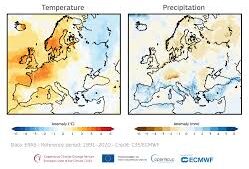GS3 – Environment

Context:
The 2024 European State of the Climate Report, jointly released by the EU’s Copernicus Climate Change Service and the World Meteorological Organization, warns that Europe is heating nearly twice as fast as the global average, with notable regional differences.
Key Findings from the Report
- Record-Breaking Temperatures: 2024 was the hottest year ever documented for both Europe and the world.
- Glacier Retreat: Scandinavian and Svalbard glaciers experienced the most severe annual ice loss on record.
- Regional Climate Variations: Eastern Europe faced warmer and sunnier conditions, whereas Western Europe was cooler, cloudier, and wetter.
- Extreme Heat Events: Southeastern European nations—such as Bulgaria, Romania, Serbia, and Croatia—suffered their longest-ever recorded heatwave.
- Fewer Cold Days: Europe observed the lowest number of ‘cold stress days’ (days below 10°C that pose health risks) and a significantly expanded region with under 90 days of sub-zero temperatures.
- Long-Term Temperature Change: Since the pre-industrial era, Europe’s average annual temperature has risen by 2.4°C, far exceeding the global increase of 1.3°C.
- Consequences of Higher Warming: This trend is leading to more severe heatwaves, erratic rainfall, frequent flooding, and increasingly brief and mild winters.
Why Europe Is Warming Faster
- Arctic Amplification: The Arctic is warming 3–4 times more quickly than the global mean, influencing adjacent European climates.
- Reduced Albedo: As ice melts, Earth’s surface reflects less sunlight, leading to more heat absorption and intensifying warming.
- Decline in Aerosol Pollution: Cleaner air in Europe, due to reduced emissions, permits greater solar radiation to reach the surface, raising temperatures.
- Land-Ocean Disparity: Land surfaces heat up faster than oceans. Europe’s land-dominant geography accelerates regional warming.
- Urban Heat Islands: Expanding cities with dense infrastructure trap more heat, making urban areas significantly warmer.
- Atmospheric Pattern Shifts: Altered wind and pressure systems are contributing to repeated summer heatwaves.
- Warming of Surrounding Seas: Sea surface temperatures around Europe have exceeded normal levels, impacting coastal weather and intensifying heat.
- Melting Glaciers: Loss of glacial mass also contributes to reduced reflectivity, reinforcing regional warming effects.
Global Implications of Uneven Warming
- Disproportionate Impact: Warming trends are more intense over land and in higher latitudes—Europe exemplifies this.
- India’s Lower Rise in Temperatures: By contrast, India has warmed by approximately 0.7°C since pre-industrial times—substantially less than Europe’s 2.4°C rise.




